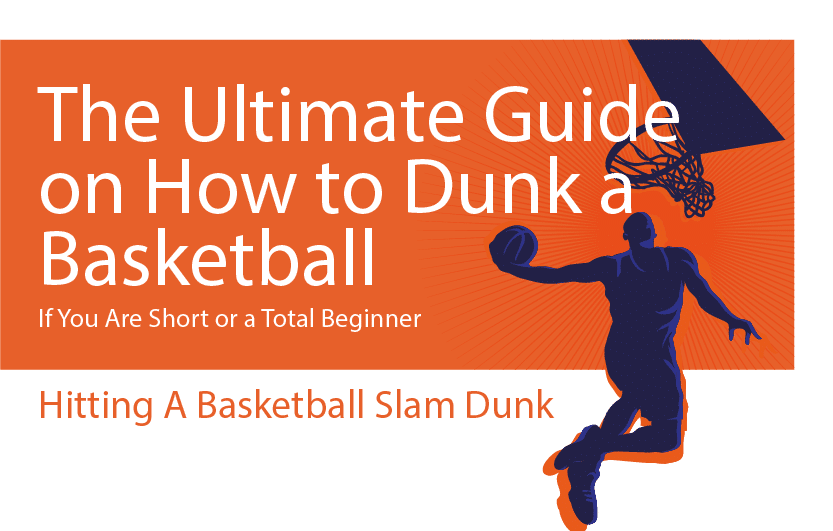
Possessing greater reach and having larger hands have always been very important facets of basketball. However, there is compelling evidence to suggest that players of below average height can dunk a basketball with considerable aplomb too.
If you have shorter limbs and a shorter torso, you can still be a marquee player on the basketball court. You too can learn how to dunk a basketball like the best in the business. Read on to find out more. Beginners will also benefit a tremendous amount from this information.
Can A Beginner Or A Short Player Dunk A Basketball?
Yes, beginners and a short player can dunk a basketball. Not only that, a short player can dunk the basketball well if he works hard at it. The two most prominent short players to excel in this particular facet of the game are Point Guards Spud Webb and Nate Robinson.
Webb and Robinson are famous for winning the annual NBA Slam Dunk Contest.
Robinson’s height was recorded at just 5’ 9” while competing as a professional basketball player. His “dunk mentor” Webb was just 5’ 7” when he won the competition two decades before that.
Both professional athletes are living proof that not only can short athletes dunk a basketball, but that short players can dunk a basketball better than most. Robinson has won the popular dunking event three times - a record.
Beginners might have a little more work to do than most but there is no reason why you cannot realize the same objective - that of learning to dunk a basketball well.

Can A 5’ 6” Person Dunk A Basketball?
The overwhelming majority of professional basketball players who fall into this height bracket (shorter than 5’ 9”) compete in the Point Guard position on the court. While basketball is constantly evolving, the traditional role of a Point Guard has not centered on scoring but rather it has centered on being a playmaker - the brains of the organization.
At a height of 5’ 6”, you might struggle to dunk a basketball but that does not mean that it cannot be done. Sadly, nobody of that height has won the NBA Slam Dunk Contest...yet!
How Do You Dunk A Basketball When You Are Short or a beginner?
If you are a short player - or a beginner - who wants to dunk a basketball with aplomb, the good news is that the goal can be achieved regardless of your background.
The bad news is that realizing that objective will require considerable preparation, effort and sometimes sheer will.
In principle, if you are a short player who wants to dunk a basketball, you need to place emphasis on increasing the height of your vertical jump. The same principle would apply for basketball beginners.
There will be more about vertical jumps later. You basically need to learn how to jump higher.
All of this can also be achieved in a relatively short space of time too.
Part of improving your preparation when you are short must include dividing your basketball training into two particular facets.
When learning how to dunk a basketball as a short player, you must focus on technique and conditioning training.
The reality is that both of these need to be well developed if you harbor any aspirations of executing a high vertical jump.
You need to jump higher in order to reach the net in basketball and in order to achieve that, you need to generate what we like to refer to as EXPLOSIVE POWER.
Your capacity to generate that explosive power hinges heavily on the strength of your leg muscles and your core. Conditioning is a critical aspect of developing that kind of muscle strength. There is no side-stepping that issue.
A significant part of developing your jumping technique will center around learning how to jump off one foot, while carrying the basketball in just one hand.
We have mentioned this so early in the blog because we believe it is without doubt the most critical factor for those harboring ambitions of honing their jumping and dunking techniques on the basketball court.
Improving technique will also include spending countless hours practicing how to palm a basketball. It seems trivial but will undoubtedly develop your capacity to dunk a basketball, especially when you are a short player. It might take some additional time for a beginner to become comfortable with this but it is by no means out of reach for you chaps either.
It is sometimes taken for granted that short players are actually better equipped basketball players (technically), especially for the role of POINT GUARD, which so many of them fulfill as professionals. That does not mean you should not work on technique though.
Remember that shorter players (like yourselves) also have smaller hands, which means that tremendous emphasis also needs to be placed on increasing your grip strength when carrying a basketball, especially when you are preparing to dunk.
Improved grip strength means that you will be better equipped to control the basketball when preparing to dunk.
Controlling the basketball better means that you will have one less thing to think about when jumping and that invariably means that you will be better placed to control your actual jump when preparing to dunk. The less a beginner basketball player has to think about, the better.
The key detail to address here is jump velocity and the control thereof. Going into your jump faster, when dunking means that you are more likely to jump higher.
Something you can do when practicing your vertical jump, is to do so by using something that is relatively easy to palm...like a tennis ball.
The emphasis here is being placed on progression. Think less about the ease with which you are holding the tennis ball and focus more on the jump itself. The tennis ball should just be there. The jump itself and your technique are closely linked and the sooner you teach yourself to do one without thinking about the other, the better off you will be on the basketball court.
Once you feel you have mastered this with a tennis ball, you can move onto something a little bigger like a volleyball. That is not quite as big as a basketball but requires a little more mental fortitude nonetheless.
Once you are comfortable training yourself in this way with a volleyball, you can then move onto the real thing - which is the basketball.
The other option available if you wish to improve the coordination of your technique is to actually lower the basketball net. It is not a sin...many people do it.
The more comfortable you get practicing this way, the easier it will ultimately be to progress to the next level. When you are ready, you can eventually center your focus on reaching a 10-foot net.
How Are Dunking And Your Jumping Ability Related?
We aren’t going to dwell too much on this here because you will find more detailed information throughout these pages, on how jumping and dunking are related.
What you need to grasp at this juncture is that all basketball players need to jump before they can execute a dunk. That is because all standard basketball hoops are higher than an average human being’s standing reach.
You cannot just stand on the surface (court) and dunk a basketball, especially if you are a short player. You have to somehow compensate for the height deficit on a basketball court and the best way to legally do that is by jumping.
The higher and better timed your jump is, the better the prospects of dunking success. We cannot overstate the importance of jumping well in basketball.
What Types Of Dunkers Are There In Basketball?
1-) The One Foot Dunker
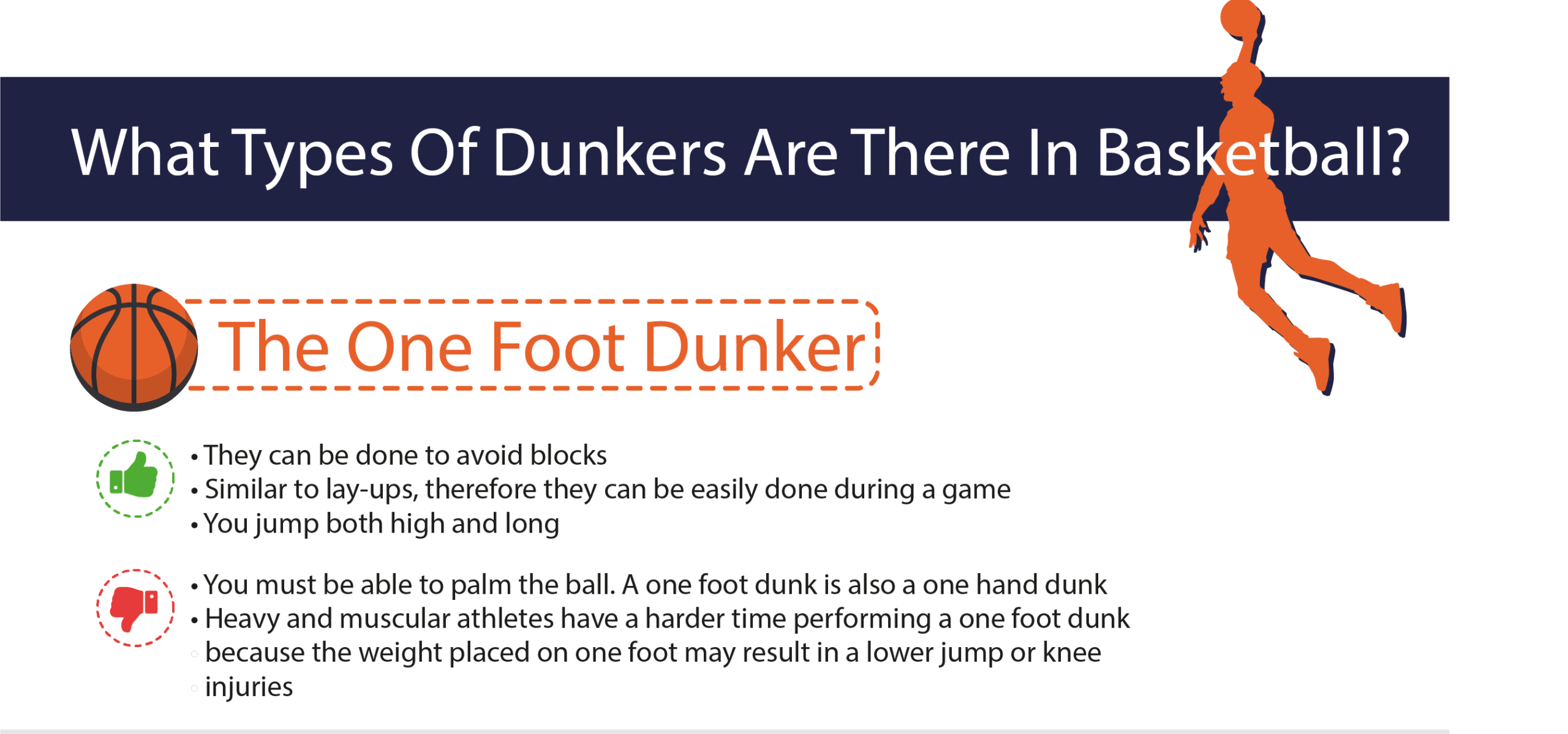
It is our strong opinion that the one-foot dunker is likely to have and enjoy the most success on a basketball court. That is because the one-foot dunker would ordinarily also only use one arm when dunking.
Using one arm means that this type of dunker will have considerably more reach when flying towards the hoop. Compensating for the height deficit between the hoop and the basketball player’s standing reach becomes considerably easier with this method. Always remember that Jumping Higher Off One Foot Is Not As Difficult As You Might Think.
Generating explosive power on the jump is also considerably easier when you are operating off the one foot. The method helps with the fluidity of the motion and the generation of your speed when preparing to dunk.
Pros:
- They can be done to avoid blocks.
- Similar to lay-ups, therefore they can be easily done during a game.
- You jump both high and long.
Cons:
- You must be able to palm the ball. A one foot dunk is also a one hand dunk.
- Heavy and muscular athletes have a harder time performing a one foot dunk because the weight placed on one foot may result in a lower jump or knee injuries.
2-) Two Foot Dunking

If you are not confident about having control over your own body and limbs in the air, despite having better speed and hang-time, dunking off the two feet becomes a useful solution once again.
Those who dunk off two feet have more of a mental battle than those who dunk off one foot. They tend to worry that they are not stable enough off the one foot. They worry that they are not stable enough in the air. Think of the second foot like a bicycle training wheel. Jumping Higher Off Two Feet It is ultimately a safety first approach.
Pros:
- Very Powerful and astounding.
- Does not require a lot of warmup, can be done from a standstill.
- It poses less pressure on the ankles and knees.
Cons:
- More time.
- Harder in games due to additional steps.
3-) The Alley-Oop

The most important element of the Alley-Oop is the pass that a basketball player makes to his high-flying dunker, to finish the ball as it floats just above the rim. In the basketball context, it is a genuinely glamorous affair. Basketball fans absolutely love it. The general rule is that the higher your dunker is and the further away he is, the more spectacular you make it look...for everybody. There is honestly nothing more majestic than the Full Alley-Oop Dunk.
Like any other, it has advantages and disadvantages:
Pros:
- It does not matter which technique you choose to jump.
- It is not necessary that you palm the ball.
- Swinging your arms will give you additional height.
Cons:
- You need to be a good passer as it requires time.
How To Build Up Your Jump?
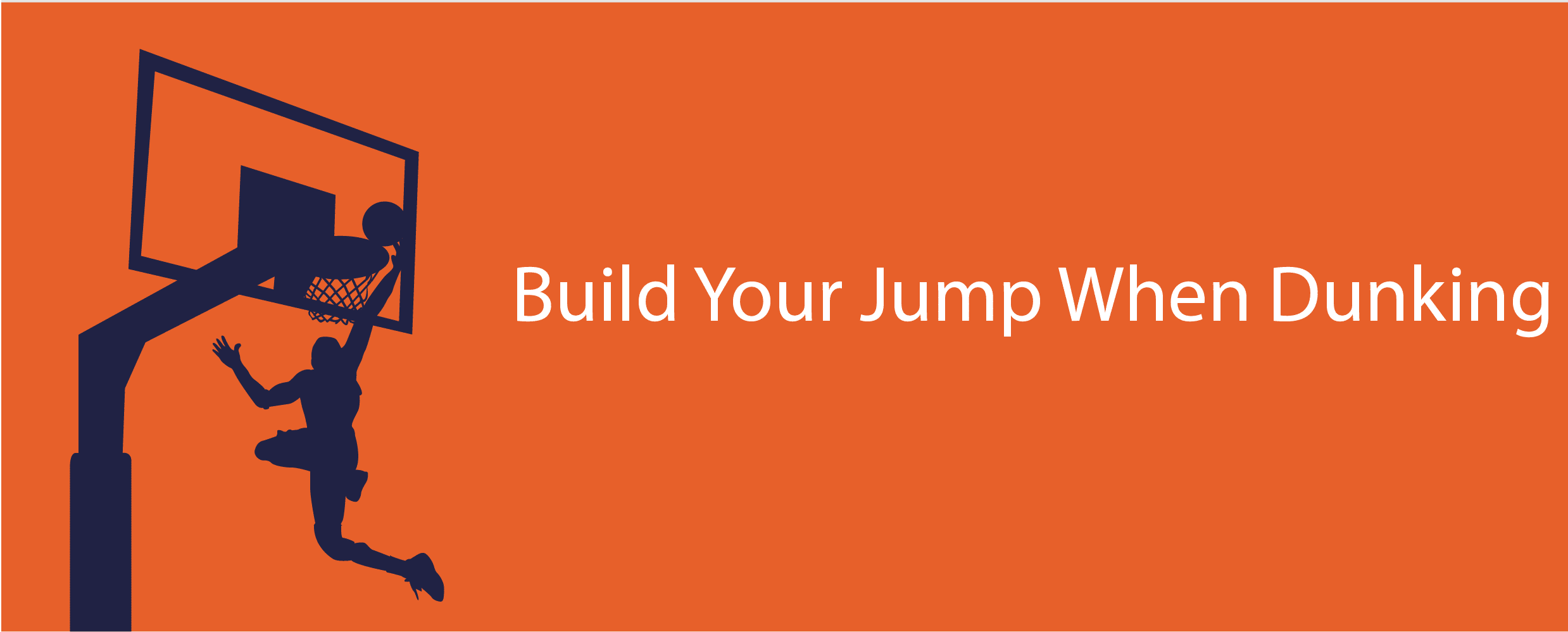
The point of departure, when learning how to build your jump, is grappling with How To Jump Higher. There are basketball-related exercises available, which can help you build your jump as a short basketball player.
Ultimately, the key to dunking better, especially if you are short, is learning to jump higher and quicker. These exercises should help get you there, by not just improving the height of your jump but by also improving the overall quality of your jump.
Those exercises include: pogo jumps; tuck jumps; depth jumps; split squat jumps; kettlebell swings; rear-foot elevated split squats; the lunge matrix; one-legged squad; front squat and paused jump squats.
There is more on all of those exercises in other posts.
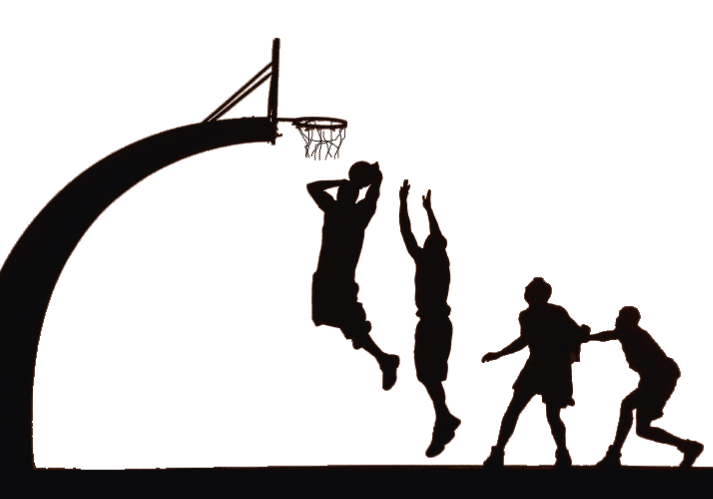
What Is A Good Vertical Jump For Dunking?
A Good Vertical Jump for dunking, if you are a professional basketball player, ranges between 44 and 48 inches. In the context of the NBA (the most prominent league in the world) Canadian Andrew Wiggins rounds off a published list of the Top Ten Vertical Jumps with a recorded jump of 44 inches.
Chicago Bulls legend Michael Jordan tops that all-time professional basketball list with a vertical jump of 48 inches. What was particularly impressive about Michael Jordan is that he also recorded a remarkable “hang time” with his vertical jumps.
While height obviously matters when recording a good vertical jump, the amount of time you spend in the air matters even more because that will enhance your capacity to dunk on a basketball court.
Not all of us are professional athletes though. If you are short basketball players in high school, an Average vertical jump of 24 inches is more than adequate. For a high school basketball player a vertical jump of 28 inches is very good. If you are a beginner and jumping at these heights, you are “dunking” well above your height. Keep up the good work.
If you are done with high school and still harbor professional aspirations, then a vertical jump of somewhere in the region of 36 inches is still pretty good and you will definitely be able to dunk a basketball at that height.
How To Practice Dunking?
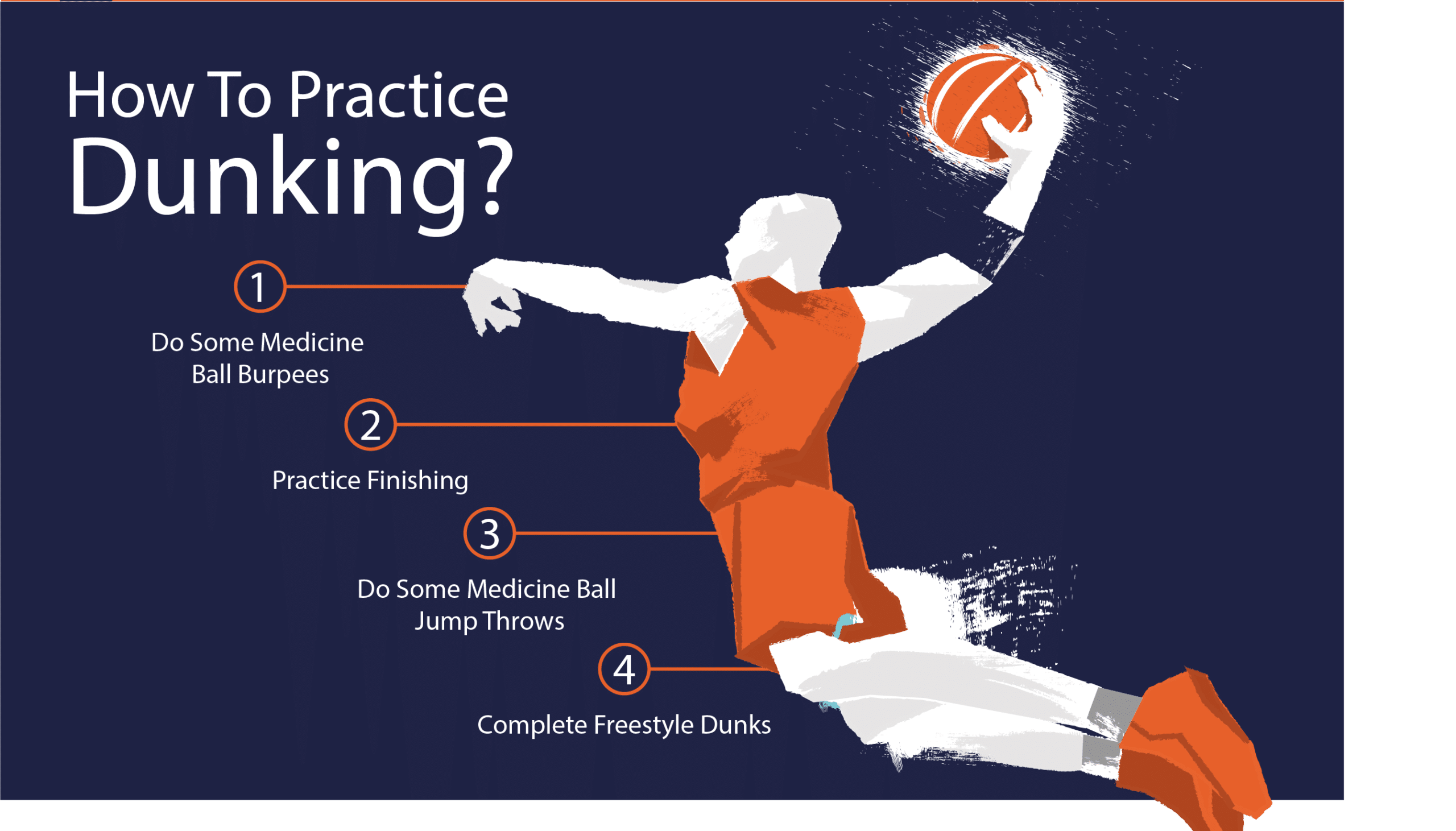
Before you actually practice dunking, you need to try to ensure your body is well equipped to develop this important basketball skill. We are going to start this segment off with a series of key exercises that will undoubtedly enhance your capacity to dunk. It does not matter if you are short or a basketball beginner. Both groups of players will benefit from these routines.
1- Do Some Medicine Ball Burpees
A burpee is an exercise traditionally used to improve the strength of your body while you are training, while also training your body to meet its energy demands - during exercise and in a basketball match situation. If you have not done a burpee before - for whatever reason - you can learn how to do that here. Invariably, this routine will be completed while Dunking With Two Hands.
- In the context of your dunk training, the plan will be to use a basketball instead of an actual medicine ball. That gets you used to the feel of a basketball in your hands and helps enhance your grip when trying to dunk.
- When you are in the push-up position, your hands should be resting on the basketball and not on the floor/court, which would obviously be the convention with the burpee. When you explode upwards into a jump from this position, you will then lift the basketball above your head while airborne and you can then touch the backboard with every repetition that you do.
- The higher you touch the backboard during this routine the better you will develop but touching the bottom of the backboard is usually good enough. The other key here is to continue this routine regularly and take note of the dunking motion (albeit with two feet and two hands) that becomes a natural part of the training regimen. The faster you complete this exercise the better. This is a sprint and not a marathon.
2- Practice Finishing
- This can be a daunting routine for somebody who has not actually mastered the art of dunking just yet, especially for the shorter players among you. Your starting position for the drill is the free-throw line.
- On each side of the free-throw line you will have two basketballs placed on the court - lined up in the direction of the net. When performing this dunk drill, you will essentially be doing four reps on each side. Your job is to alternate sides with every rep.
- The goal of the exercise is to pick up one of the balls at a time with both hands, carry it towards the hoop with both hands and hold the basketball with both hands when making the jump towards the hoop.
- An important detail to take into account here is that you do not actually have to make the dunk while still starting out with this drill. If you are battling, it will be perfectly adequate to be touching the backboard with the basketball before dropping it and starting a new rep.
How long you continue with this drill is completely in your court. We suggest that you keep at it until you are comfortable and confident that you can actually make the dunk. Keep attacking the rim, while jumping as high as you can every time.
3- Do Some Medicine Ball Jump Throws
- You will start this drill in a kneeling position on the basketball court, while facing the wall. Use both of your arms to lean on a basketball (instead of a medicine ball).
- Next you will push your entire body up, as you would when doing the medicine ball burpee that we described in exercise routine 1 above.
- Once you are on your feet, you will then explode (for lack of a better term). Instead of jumping towards the hoop/backboard, you will jump straight up and then throw the basketball directly at the wall you are facing.
- It gets more interesting too. Once you have thrown the basketball at the wall, you will then turn around and sprint towards the other end of the basketball court. You are looking at completing something in the region of a 15-yard sprint here.
As with any exercise that falls within this bracket, try and do as many reps as possible, before you get sick or start falling over. This is as much mental, as it is physical.
4- Complete Freestyle Dunks
There is an element of freedom associated with this dunking exercise, which you would ordinarily do when you have learned how to make the dunk regularly. The convention would be to start off your run from any of the regular attacking positions on the basketball court - basically just outside the free-throw area. You can then run in towards the hoop, jump and dunk. Try and make as many hoops as you can while carrying out the technique. It is as simple as that.
For all of these dunking exercises, you are looking to complete something in the region of four sets.
Each set should be at least eight reps. It is important that you complete these exercises with maximum effort, otherwise they can actually prove to be counterproductive. Push your body to the limit here. Most of this routine will be conducted while Dunking With One Hand.
How Tall Do You Have To Be To Dunk A Basketball?
The most important thing for any short player to grasp is the standard height of a basketball net, which is 10-feet high.
We have briefly touched on the mental approach in this blog post already - and that will be particularly relevant here. Once you make a mental note of how high you need to jump, before dunking a basketball, you can complete the rest of your preparations accordingly.
You already know how tall you are, how tall your torso is and how long your limbs are.
Being a good dunker does not really hinge on How Tall You Should Be though. It probably matters a little more if you are a basketball beginner or not.
If it helps, the generally accepted rule is that a standing reach of a 6-foot tall player is something in the region of 8-feet. It stands to reason that you will then need to find a way to compensate for that additional 2-feet. As we have already explained, 2-feet can be a lot in basketball.
Once you have made those mental notes, you then need to figure out how high you need to jump before you can comfortably place your hand above the hoop. To assist with the mental calculations, you will note that your fingertips will probably need to be somewhere in the region of 10’ 6” above the ground to make a comfortable dunk.
Tips and Caution

Now that you can easily dunk and you’re the star of every show, there a couple of things you need to be wary off to avoid injuring or embarrassing yourself:
Look out for your hands: Not all courts have the best and updated equipment, so the rim itself might be rusty and messy from lack of maintenance. Watch out not to tear your hand open.
Look out for your ankles and knees: If you are a short guy (under 6 foot) like myself, a fall from a high jump is not an easy one. You have to be careful, especially around other players. Injuring your knees or ankles will get in the way of you being the star of the season.
Practice on a stable goal: Those things will fall over the moment you put weight. So unless you want to become the meme of the month, you stay away from those.
There’s no need for you be constantly grabbing the rim: Don’t be an idiot who’s getting his team fouls. If it is done incorrectly, you could lose balance and injure yourself and other players.
Conclusion
Let us not delude ourselves here. Being short is a severe disadvantage when you are a professional athlete, especially if you are a basketball player who wants to dunk the ball in a competitive environment.
However, as with anything in life there are options available to help you realize your “dunking objectives”. If you take anything away from this blog, it needs to be that short players MUST NOT be intimidated by the prospect of dunking in basketball. Most of that improvement will center around jumping higher in basketball.
A wise man once said that it always seems impossible until it is done. With the right technique, conditioning and effort short players can dunk a basketball just as well as the tallest in the business.
Hey, I’m Aleksandar and I am a Basketball freak! That is why I decided to create this blog. Teaching people How to dunk a basketball and How to Jump Higher in this sport or other related sports that require vertical jumping, is my specialty. If that’s your aim, then you have come to the right place.
